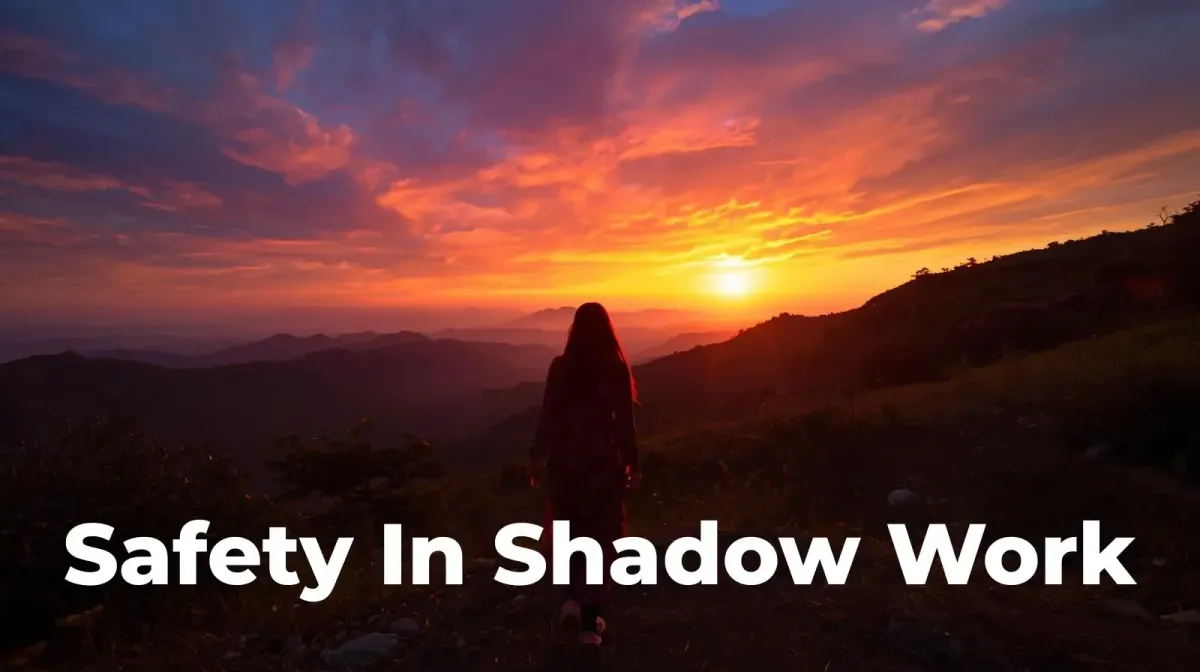Peter Paul Parker's Official Website
Articles And Guidance

Empath Shadow Work: Safety-First Map
Shadow work can be beautiful and brave. For empaths, it must also be safe. Your system feels more. You absorb more. You process more. That means the order matters: body first, then mind, tiny steps, and a kind close every time.
Safety box — use before you begin
Breathe low and slow for 60 seconds.
Quick window check: “Am I steady enough to feel + think at the same time?” If not, ground first.
Name a boundary for this session (time limit, topic, exit plan).
Prepare your close (warm drink, music, a short walk).
For foundations, you can skim What Is Shadow Work? A Complete Guide and Shadow Work Safety: Tiny Steps That Work. This guide builds on both, tailored for empaths.
Why empaths feel more (and what to do with it)
Being an empath often means high emotional absorption, strong mirror responses, and a tendency to prioritise others. This is a gift and a load. It brings intuition, compassion, and connection. It also brings overwhelm and energy leaks.
Key reframe: You are not “too much.” You are finely tuned. The work is to shape how you sense, not to stop sensing.
Three steadying truths
You can pace insight so your body keeps up.
You can separate what is yours from what is not.
You can choose safe doses of work and finish calm.
If you are brand new, start with Shadow Work for Beginners: A Gentle Guide for Empaths.
Window of tolerance & titration (quick self-checks)
Your “window” is the range where you can feel and think without flooding or shutting down. Outside the window, shadow work becomes re-wounding. Inside the window, it becomes growth.
Pre-session 30-second check
Body: jaw, belly, hands relaxed enough?
Breath: slower than your thoughts?
Mind: can you hold two ideas at once (feeling + observation)?
Titration rule: Choose one tiny piece of truth. Touch in. Step out. Integrate.
Signs to pause
You start people-pleasing mid-practice.
Your body goes numb, dizzy, or tingly in a fear-spike way.
Thoughts become all-or-nothing or self-attacking.
When in doubt, shorten the session, lower the intensity, and come back later. Pair this article with Emotional Healing & Emotional Trauma: The Complete Guide for wider nervous-system context.
Body-first grounding (2-minute resets you can trust)
Shadow work for empaths should begin in the body. Think of these as the “on-ramps” into safe work.
Pick one 2-minute reset:
Weighted breath: inhale for 4, hold 2, exhale for 6. Feel your seat and feet.
Self-hold: one hand on heart, one on belly. Slow sway. Whisper, “I’m here.”
Tap & brush: gentle tapping around the collarbone and upper arms. Brush down the arms to the fingertips.
Orienting: name five safe things you can see and one sound you enjoy.
If you find tapping useful, fold it into your journalling practice from Shadow Work and Journaling: Writing Prompts for Self-Discovery.
Two-Minute Reset (Copy and Use)
Breathe low and slow for one minute.
Brush down the arms to the fingertips.
Whisper: “I’m here and I’m safe.”
Name one boundary for this session.
Use this before any prompt or reflection. It keeps you in your window.
See also:
Shadow Work for Empaths: Gentle Prompt
People-Pleasing and Fawn-Aware Boundaries
Fawn-aware boundaries (scripts + micro-experiments)
Many empaths run a fawn response under stress: we appease and over-agree to stay safe. Shadow work helps you notice this pattern and choose differently.
Two pocket scripts
“I need a moment to check in with myself before I answer.”
“I want to be honest and kind. I’ll come back to you after dinner.”
Three micro-experiments this week
Say, “Let me think about that,” once per day.
When you feel “Yes!” but mean “No,” buy time. Message later.
Schedule a self-check window after any emotionally heavy call.
Deeper practice lives here: People-Pleasing and Boundaries: From Shadow to Self-Respect and Shadow Work and Relationships: Healing Triggers with Compassion.
A tiny, safe session structure (15 minutes total)
1) Open (3 minutes)
Choose one reset above.
Set a time boundary. Put a timer on.
Name your aim: “I’m exploring why I apologise when I’m not wrong.”
2) Touch the shadow (7 minutes)
Write three lines: What happened? What I felt. What I needed.
Ask one gentle question: “What am I afraid will happen if I say no?”
If strong emotion rises, step out. Breathe. Tap. Return only if steady.
3) Close (5 minutes)
Write one sentence of self-respect: “I’m allowed to pause.”
Shake arms, roll shoulders, or walk to the window.
Warm drink. Music. A brief smile at something you love.
This is your “always-safe” container. If the inner child appears, glide to Shadow Work and the Inner Child: Healing the Wounds You Carry Within for extra care.
Prompts that respect sensitive systems
Use prompts that build clarity without dragging you into the deep end. Stop at the first sign of flooding.
“When I say yes too fast, I’m usually trying to avoid…”
“A small boundary that would help me today is…”
“If I could tell the truth kindly, I’d say…”
“What part of me needs a hug, not a lecture, right now?”
“One tiny way I can conserve energy this week is…”
Pair with Shadow Work and Self-Love to keep tone warm and shame-free.
Close & aftercare (finish grounded, not flooded)
Always land the plane. Your system learns safety from how you finish.
5-minute close
Name three body sensations that feel neutral or pleasant.
Lengthen your exhale for eight breaths.
Choose one nourishing act (stretch, sunlight, music).
State one boundary aloud you will keep today.
Thank your body for protecting you all these years.
If you share space with loved ones, try a 60-second co-regulation: sit back-to-back, breathe slowly, match the rhythm, then hug if it feels right.
Weekly plan (gentle and repeatable)
Mon — 10-minute session (boundary theme).
Wed — 10-minute session (anger or guilt without shame).
Fri — 15-minute session (relationships + repair script).
Weekend — reset only. No heavy work. Nature, rest, creativity.
If you’re unsure whether you’re empath, HSP, or both, read What Is a Highly Sensitive Person? and adapt the doses.
Common mistakes to avoid
Chasing “big breakthroughs” every time. Go for small, steady gains.
Skipping the close. Your body remembers the ending.
Doing deep work while dysregulated. Regulate first. Work second.
Using prompts as self-attack. If the tone turns harsh, stop and reset.
FAQs
Is shadow work safe for empaths?
Yes, with pacing. Stay inside your window, titrate topics, and keep sessions short. Always close with breath, movement, and a boundary.
How often should I do this?
Two to three short sessions per week is enough for most empaths. If life is intense, halve that and prioritise grounding.
What if I start fawning mid-conversation?
Pause: “I need a moment.” Place a hand on your belly. Breathe. If needed, say, “I’ll reply later.” Then journal one line about what you actually want.
Which prompts are best?
Prompts that return you to self-respect and clarity. Avoid “why am I like this?” in favour of “what would feel kind and honest now?”
How do I know when to pause shadow work?
If you can’t stabilise after two minutes of grounding, or if you feel numb, dizzy, or panicky, stop and reset your day around care, not insight.
Read Next
Shadow Work for Empaths: Gentle Prompts
People-Pleasing: Fawn-Aware Boundaries
Shadow Work for Empaths in Relationships
In Conclusion
Empath shadow work thrives on sequence: ground → titrate → touch truth → close. Keep doses small. Protect your window. Practise fawn-aware boundaries. End every session calm. When you treat your sensitivity as wisdom, the work becomes lighter, kinder, and real.
Next steps
You don’t have to do this alone. If spiritual overwhelm keeps knocking you out of your window—or you feel lost between big openings and everyday life—these two gentle paths give you practical support for exactly what we’ve covered:
Free Soul Reconnection Call — A calm, one-to-one space to settle your system, set spiritual boundaries, and design tiny, repeatable rituals so your practice feels safe, embodied and sustainable.
Dream Method Pathway — A self-paced, 5-step map (Discover → Realise → Embrace → Actualise → Master) to heal old loops, build daily regulation, and integrate spirituality into a stable, meaningful life.

Choose the route that feels kindest today. Both are designed to help highly sensitive people grow spiritually with steadiness and self-trust—gently, steadily, and for real change.
I look forward to connecting with you in my next post.
Until then, be well and keep shining.
Peter. :)
Feeling Spiritually Lost? 🢂
Copyright Peter Paul Parker 2023 <<< ✺✺✺✺✺✺✺✺✺✺✺✺✺✺✺✺✺✺✺✺✺ >>> Terms And Conditions - >>> Privacy - Linked In - YouTube - Facebook -
